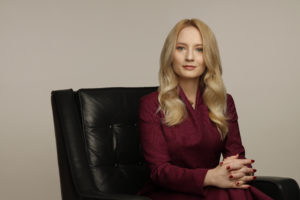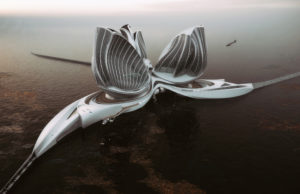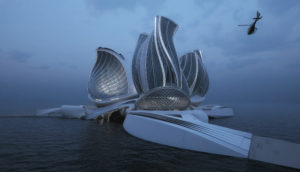There is a pressing need to clean up the world’s oceans. Both the health of our oceans and climate change are linked as oceans play a vital role in absorbing carbon dioxide. Plastic pollution, 8 million tons of plastic every year, threaten all marine life. Ocean species are facing a bigger danger of extinction than species on land. It is clear that the oceans are at the epicentre of the planet’s environmental crisis.
Tali Ramsey, ideaXme contributor spoke with Lenka Petrakova to explore how mankind might address the oceans’ mounting crisis.

Lenka Petrakova, Award-Winning Designer and Architect
Architect Lenka Petrakova is designer of the 8th Continent, a design concept of a floating station to rid the ocean of plastic waste. The ocean based floating station is completely self-sustainable and works to remove plastic while also functioning as an ocean research facility.
The pioneering concept received the 2020 Grand Prix Award for Architecture and Innovation of the Sea from La fondation Jacques Rougerie, an initiative established to courage innovation in architecture in coastal, sea and space areas.
Fascinated by oceans, Lenka’s exploration of life underwater led her to contemplating how to help the marine environment to help save the world from environmental catastrophe. Interested in architecture for its duality as both an expression of art and functionality, the 8th Continent is a shining example of how architecture can provide functional spaces for the greater good.
Below, read the full interview transcript.
Tali Ramsey, ideaXme guest contributor: [00:00:22] Welcome everybody to ideaXme, the global platform that moves the human story forward. I’m Tali Ramsey, an ideaXme guest contributor and writer specialising in contemporary art, internet culture and society. Today, I’m joined by Lenka Petrakova, an award-winning architect and designer who currently works at Zaha Hadid Architects as a senior architect. She’s the mind behind the 8th Continent, a floating station concept designed to clean up our oceans. Lenka, in your own words, who are you?
Lenka Petrakova, designer and architect: [00:01:01] I am an architect and a designer and an enthusiast for our environment. I am interested in architecture’s ability to support a more sustainable future by implementing environmental strategies and technology. I am the creator of the project the 8th Continent – an ocean cleaning and research facility that could help us not only restore the marine balance in the future but also develop a greater awareness about the oceans.
Tali Ramsey, ideaXme guest contributor: [00:01:24] The health of the oceans and climate change are intrinsically connected because the ocean absorbs a significant portion of the carbon dioxide emissions caused by human activities.
Tali Ramsey, ideaXme guest contributor: [00:01:42] As well as this, when plastic does break down, it only breaks down into microplastics, which enter our food chain via animals many of which humans then go on to eat. Can you talk a bit about the research process relating to climate change and ocean health which forms the basis of the 8th Continent?
Lenka Petrakova, designer and architect: [00:02:05] I started developing this project as my thesis at the University of Applied Arts in Vienna. To create the brief for the project, I researched available information, and I had the chance to discuss with experts on ecological design at the university. I was not only looking at ocean pollution problems, but I was researching ocean life and how ocean plants and animals behave and adjust to the dynamic environment. Sadly, I haven’t had the chance to see the great Pacific Garbage Patch and research the location on my own due to the timescale.
Tali Ramsey, ideaXme guest contributor: [00:02:38] The temperature of the oceans is increasing year after year, which impacts the health of the oceans, everything in it and of course climate change.
Tali Ramsey, ideaXme guest contributor: [00:02:53] How do you see architecture evolving to help mitigate these crises?
Lenka Petrakova, designer and architect: [00:03:02] I have a few projects connected to the ocean and climate crisis; however, I’ve never researched a process that links the possibility of mitigating sea temperature by architecture. It is an exciting idea, but currently, among architects, you can see more work that addresses rising sea levels due to the ice and poles melting and the sea water expansion. So, we have to solve this by architectural proposals to facilitate our waterfront as the floods would otherwise destroy many cities worldwide.
Lenka Petrakova, designer and architect: [00:03:37] For the very long-term view, if we have to move the cities deeper into the Continent, we face the problem of really high temperatures as the surface is heating up increasingly. So, there might be a point when we will build much more on the sea to have a better climate and still be close to the nutrients.
Tali Ramsey, ideaXme guest contributor: [00:04:05] Can you talk a little bit about the plastics industry and your opinion on how to mitigate the plastic crisis?
Lenka Petrakova, designer and architect: [00:04:16] There are many different options. First of all, there are many types of research into bioplastics, which are easier to produce and recycle. There are now new bacteria that nature created to help to degrade plastic. I believe one of the essential parts is to change our consumption habits. We all talk about how the technology and products used to be of higher quality and stayed with us for many years. Currently, most products are made of cheap materials, and we need to buy the same items much more often. Therefore, we use much more resources to develop these products and then to recycle them. It’s not sustainable. Part of the problem can be solved by focusing on our consumer habits.
Lenka Petrakova, designer and architect: [00:05:03] However, the position has to be changed at a higher level with substantial restrictions on the material requirements and technology requirements. This has to be global, otherwise we will never change it. Of course, it’s a large issue that would impact many producers and their livelihoods. I believe it might be more of a significant issue than we think, because it’s not only about plastic, but also about the way we live and how the economy is set up. It’s time to have these enormous systematic changes to save our planet.
Tali Ramsey, ideaXme guest contributor: [00:05:42] You recently received the prestigious 2020 Grand Prix Award for Architecture and Innovation of the Sea. How did the 8th Continent meet the award’s criteria? Why do you think that the 8th Continent won? Furthermore, what inspired the concept?

Lenka Petrakova, designer and architect: [00:06:01] From the concept point of view, I’ve always found oceans fascinating, they have enormous energy on the territories dominated by nature, at least I thought. After careful observation and study, I realised how destroyed they are, how many species are extinct, how much pollution there is and the parts that may never have seen a human being, feel the effect of our activities. After looking into the marine environment only for inspiration, I started to look at how I could help.
Lenka Petrakova, designer and architect: [00:06:36] This year there were 1694 participants in the competition, among three categories. I believe many more projects were concentrating on the plastic pollution issue, but the strength of this project is in its focus on the combination of the physical cleaning of the ocean with the research and education centre. It creates an interdisciplinary platform in the sea, as well as a self-sustainable piece of architecture.
Tali Ramsey, ideaXme guest contributor: [00:07:15] You said that there were also projects that worked on the plastic crisis in the oceans. So, has something similar being proposed before, not just in that competition, but in general? Have you seen anything that comes close to what you proposed?
Lenka Petrakova, designer and architect: [00:07:37] There are other projects that consider the ocean cleaning, and some are already in the testing stages on the ocean. However, none of them are involving the community and none of them are self-sustainable stations implementing partial recycling on the water as mine is.
Tali Ramsey, ideaXme guest contributor: [00:08:34] The 8th Continent is designed to be both a method of cleaning up the ocean’s plastic and a research centre. How will it function?

Lenka Petrakova, designer and architect: [00:08:48] The station consists of five different parts. The first one is the barrier that serves to collect waste and harvest tidal energy. The second one is a collector where waste is sorted, degraded to a certain extent and stored and the third one is a research and education centre to study and showcase the increasingly troubling condition of the aquatic environment. The fourth part is the greenhouses where plants are grown and water is desalinated, and the fifth one is the living quarters with support facilities and public spaces.
Lenka Petrakova, designer and architect: [00:09:24] Each of the main parts is developed based on the required environmental characteristics and the program they carry. The barrier floats on the water surface and moves waste towards to collector. The collection technology at the centre of the building is designed to optimise waste handling. The water is filtered and then the waste is sorted and, to a certain extent, recycled. The research and education centre are linked to the collector and greenhouses to follow the water processes and study them.
Lenka Petrakova, designer and architect: [00:10:00] The greenhouses are shaped to optimise condensed water collection and reassemble large sails to allow wind to navigate the station. Solar panels cover the greenhouses and ensure there’s enough power for the water reservoirs heating which allows water to desalinate over the process of evaporation and condensation. After the wastewater extraction, the filtered clean water is pumped to these tanks and either the desalinated or the salt water is used for halophilic plants hydroponic cultivation. The living quarters, public spaces and support facilities pass through the building centre and connect all the parts geometrically matching the ship’s keel to stabilise the station on the water.
Tali Ramsey, ideaXme guest contributor: [00:10:58] The researchers will be living on board and collecting information on the oceans, and I suppose that’s a big part of what sets your project apart from similar projects. What type of specialists do you imagine working there across disciplines?
Lenka Petrakova, designer and architect: [00:11:22] First, of course, there’s going to be technicians taking care of the station and researching how technology should be developed to address the issues on the water. Their analyses should be used to further adjustments of the system.
Lenka Petrakova, designer and architect: [00:11:22] Then, I’m thinking about marine biologists, who would have the opportunity to look at the development of life under the water and if there is any improvement. Also, chemists can look at how the plastic is broken up and what are the changes to plastic due to the salty water because currently I’m thinking of only a limited amount of recycling on the station due to the extensive process connected with it. I see the project as a platform where everyone who is interested in the marine environment or has another way of helping can come and use this platform for their research.
Tali Ramsey, ideaXme guest contributor: [00:12:51] Your project addresses the Great Pacific Garbage Patch, which is a floating island of plastic waste located in the central Pacific Ocean, called the 8th Continent which extends over an area of 1.6 million square kilometres. Have you proposed that the station is moving, or will it be static? Secondly, it operates utilising tidal energy, but how is it designed to deal with adverse weather conditions that is variations in tides and wind?
Lenka Petrakova, designer and architect: [00:13:28] The station is developed to be located on the open sea. It should be anchored to the seabed, but this connection should allow a station to move with the current for better garbage gathering. It’s essential to consider the sea’s depth for the clearance of the station, which is 60 metres under the water level, but at the same time, the height of the seabed should allow the station to be anchored.
Lenka Petrakova, designer and architect: [00:14:02] The position also depends on the water currents and it should be located at the part where the ocean currents naturally gather the garbage. Adverse weather conditions have been considered as far as there would be another water structure design, compartmentalisation is proposed. The station’s primary geometrical language is a buoy, and the barrier can fold inside the station, which will decrease its size to only 200 meters in width, which is considerably smaller than many commercial boats.
Tali Ramsey, ideaXme guest contributor: [00:14:37] What materials would be used to build it? You have solar panels on the greenhouses, is there anything else you’ve proposed in particular?
Lenka Petrakova, designer and architect: [00:14:49] The material definition was not part of the competition brief. I don’t have very detailed specifications. My idea was that the outer shell would be constructed as a commercial boat, so from similar materials that are already proven to be resistant and durable in these conditions. The interior would be partially built before people move onto the station; the technology would be integrated. The parts that are not essential could be made on site from the station’s recycled plastic. So, the cleaning station is partially built from the pollution that it collects.
Tali Ramsey, ideaXme guest contributor: [00:15:28] Going back to the competition and your competitors. Did anyone stand out in a way that you could see yourself working with them in collaboration to restore the marine’s environment?
Lenka Petrakova, designer and architect: [00:15:45] The foundation encourages its laureates to join the junior ambassador program and cooperate for longer periods of time. I can imagine cooperation on projects to raise awareness of the current environmental issues and promotion of architecture that can solve them. Of course, the awarded projects are interesting, and I believe there would be a potential to develop a common project, as we all have to common hope for a better planet and we wish to help it become a reality.
Tali Ramsey, ideaXme guest contributor: [00:16:25] Can you say whether it will actually be built and if not, what is required to actualise the project?
Lenka Petrakova, designer and architect: [00:16:33] I based the design on existing technology and materials, so it’s anchored in the real world, but it would need a detailed development and experts to work on the technology and study the construction details. As any architectural work, it needs an investor and time to be specified.
Tali Ramsey, ideaXme guest contributor: [00:17:49] Can you estimate the cost that it would take to build?
Lenka Petrakova, designer and architect: [00:17:53] It’s too early in the process to make estimations.
Tali Ramsey, ideaXme guest contributor: [00:17:58] If you could connect with anyone to move the project forward, who would it be and why?
Lenka Petrakova, designer and architect: [00:18:06] I believe Elon Musk would be a great patron of the project, with his energy and excitement pushing the technology forward and researching new territories. His focus for things that interest him is well known, and I believe it could help move this project the right way. On the other hand, I think this project could be of interest to him. However, it is not connected to space, but the self-sustainable concept could be developed for the 8th Continent and later applied to other frontiers.
Tali Ramsey, ideaXme guest contributor: [00:18:19] You work at Zaha Hadid Architects as a designer and architect. What has been your most exciting project to date while in the role?
Lenka Petrakova, designer and architect: [00:18:32] In May, it will be four years. Every project is exciting in its own way and each project is very specific and unique in its context such as local culture, programmatic requirements and engineering to enable the architecture and surrounding fabric to combine and formal strategy and spatial experience. Sadly, I cannot share any projects that I work on, but I hope that very soon I can get back to you and invite you for an opening.
Tali Ramsey, ideaXme guest contributor: [00:19:10] Zaha Hadid herself was a pioneering figure in architecture of the late 20th and early 21st centuries and she was known for her deconstructivism style. Has her work inspired you?
Lenka Petrakova, designer and architect: [00:19:29] Yes, I was following her work for a very long time. I wanted to be a painter when I was younger, and her drawings and paintings captured my attention at the time. She was, for me, an inspiration, in the sense of her work as well as her personality, I had the opportunity to meet her at university in Vienna.
Lenka Petrakova, designer and architect: [00:19:50] Her criticism of any project was always eye opening. She was a visionary but at the same time, she was enormously interested in the technology and in the practical side of architecture and how people use the space, and their experience should be an integral part of the design. Sadly, I was not her student, so I never got a direct critique from her but listening to her discussions with my student colleagues inspired and shaped my work. I love that at the office we are all huge fans of the work and we all enjoy travelling to destinations of projects by Zaha Hadid Architects. We are inspired by the creation of the colleagues that worked at the office before and it’s an enormous honour to have the opportunity to contribute to developing the legacy of this brand.
Tali Ramsey, ideaXme guest contributor: [00:20:41] What inspired you to become an architect? You said that you wanted to be a painter originally, which is interesting. Could you talk of your interest in art? Moreover, the extent to which that played a role in inspiring your career in architecture?
Lena Petrakova, designer and architect: [00:21:04] I’ve attended art courses since my childhood, and I was always interested in paintings. I was interested in how people perceive image and space.
Lenka Petrakova, designer and architect: [00:21:19] Later, I found this other interest in technology and architecture. Architecture, for me, was the clear choice as a combination of aesthetic, function and technology. When I was trying to study for painting courses, one professor told me that if I want to be a painter, I don’t need to breathe or speak or talk or do anything else than paint. After years working, I can say that I’m happy I found this obsession in design and architecture.
Tali Ramsey, ideaXme guest contributor: [00:22:10] You’ve worked on projects that help the environment, such as the ARKantica that proposes using drones to collect existing biomaterial in unexplored Antarctica and then, of course, there’s the 8th Continent, as we’ve discussed. Moving on from environmental issues, how do you see space being utilised to aid social and cultural progress?
Lenka Petrakova, designer and architect: [00:22:41] The beauty of architecture is in its possibilities. Every architectural work combines aesthetics, technology, fabrication techniques and materiality. It has a large social and economic impact. The architects are, for me, conductors that integrate and synchronise all of the different aspects to create one final piece. Architecture, from its beginning, had the ability to support progress and change perceptions. With the increase of technology, we can change the way we design and support the integration of technology to help the environment.
Lenka Petrakova, designer and architect: [00:23:42] We have an opportunity to integrate new materials and bring our buildings closer to the behaviours of nature. It all depends on our power to integrate these visions on how the world will look tomorrow. Jules Verne said, “anything one man can imagine, another man can make real” and I hope we can visualise better, more sustainable constructions that will support our communities and nature.
Tali Ramsey, ideaXme guest contributor: [00:24:12] Thank you for speaking to me about the 8th Continent and your motivations and inspiration for creating it.
Lenka Petrakova, designer and architect: [00:24:21] Thank you very much.
Credit: Tali Ramsey, ideaXme contributor and journalist.

If you enjoyed this interview, please check out Living Architecture.
Find ideaXme across the internet including on iTunes, SoundCloud, Radio Public, TuneIn Radio, I Heart Radio, YouTube, Vimeo, Google Podcasts, Spotify and more.
ideaXme is a global podcast, creator series and mentor programme. Our mission: Move the human story forward!™ ideaXme Ltd.

